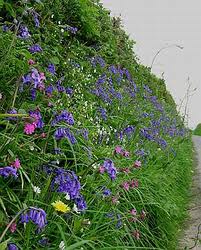





The traditional mixed hedgerows that border many fields and lanes are a vital link in the chain that supports wildlife. The best wildlife hedges are those that are joined to other hedges or areas of woodland: this network of hedges and trees provides ‘wildlife corridors’ along which animals can safely travel from one area to another. Garden hedges may exist in isolation from this network, but they are still a valuable resource for wildlife.
 Many garden hedges consist of a single species, like beech, hornbeam, holly, privet or yew. These hedges are a good choice where the garden is fairly formal, because they can be regularly cut to form a neat and tidy barrier, but they are not particularly wildlife-friendly. Although the dense branches may provide cover for small mammals and nesting sites for birds, and many contain spiders and other insects, the frequent cutting of the hedge will mean that it produces little or nothing in the way of flowers or fruit.
Many garden hedges consist of a single species, like beech, hornbeam, holly, privet or yew. These hedges are a good choice where the garden is fairly formal, because they can be regularly cut to form a neat and tidy barrier, but they are not particularly wildlife-friendly. Although the dense branches may provide cover for small mammals and nesting sites for birds, and many contain spiders and other insects, the frequent cutting of the hedge will mean that it produces little or nothing in the way of flowers or fruit.
Less formal hedges of Rosa rugosa or Berberis are often used to separate different areas of the garden, and these hedges are usually allowed to flower and fruit with just an occasional cut to keep the growth under control. The flowers of both of the above hedging plants are visited by bees and bumblebees, the fruit and any resident insects are eaten by birds, and nesting sites may be found within the protection of their prickly branches.
Hints and Tips
Take a trip out along any country lanes near to where you live, and make a note of all the different plants you can identify growing in the hedgerows.
Plant a new hedge when the plants are dormant, from late autumn to early spring, to allow the roots time to establish.
Where the garden is informal and the boundaries abut fields or woods, it should be possible to plant a traditional hedge with a mixture of species. These hedges are never as tidy as a single-species hedge but are much more interesting, with a variety of leaf colours and textures and, if left uncut until late in the season, plenty of flowers and fruit to add to their appeal. Once the hedge is growing well, plants such as dog roses, honeysuckle, brambles and old man’s beard can be planted to scramble through it, adding extra colour and interest.
Plant a selection of low-growing wild flowers such as primroses, violets and red campion at the base of the hedge; these will give early-spring interest and add to the overall pleasure. When the hedge is fully established, it will require no more than a yearly trim. The coarser plants growing in and around it should be removed from the hedge base to keep it in order.
Many farm hedgerows were originally single-species hedges of hawthorn that gradually became mixed as other plants drifted in with the wind or were carried by birds and small mammals. Nowadays we start by planting a mixed hedge, but usually still allow the hawthorn to predominate. There are various hedgerow mixtures, so select one with plants suitable for your soil. Most hedging plants are suitable for most soils, but chalky soils will favour a mixture with the following ratio: 5 hawthorn: 3 dogwood: 3 field maple: 2 spindle: 2 hazel: 1 wayfaring tree; whereas on a damp soil willow (Salix), guelder rose and dogwood will flourish.
Copyright © www.100flowers.win Botanic Garden All Rights Reserved